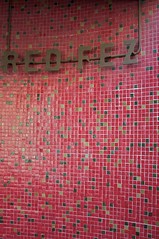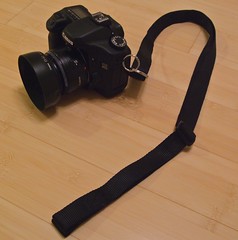 The Problem
The ProblemOne huge difference between SLR and point and shoot cameras is that you can't just store the SLR in your jeans pocket. If you want to carry a SLR around ready to shoot, you'll want a strap of some sort.
The neck strap that arrived with my Canon 40D dSLR camera drives me bonkers. It's ugly, to start, with lots of colorful branding calling attention to the camera. It gets twisted up, it blocks the viewfinder when I try to take photos, it makes my neck sore, and it makes me sweat on hot days. In some ways, a simple rope might be better.
If I actually wear the strap, it bounces and smacks me in the chest while I walk. Sometimes the bounces activate buttons on the camera. It protects my camera from drops, but not from smacking tables when I lean forward. It does prevent the camera from hitting the ground, but so would gluing the camera to my hand.
The R-Strap
I've been searching for a replacement strap ever since getting the camera. I strongly considered getting a Black Rapid R-Strap. Instead of going around the neck, the R-Strap goes over a shoulder and across the chest. The camera clips to the strap via a threaded bracket screwed into the tripod socket. It sounded great until Scott Bourne published his Black Rapid RS-2 review on TWIP.
Scott had such a bad experience with his RS-2 that he intentionally destroyed it. Scott had two incidents where the strap malfunctioned and dropped (or nearly dropped) a Nikon D700. In one case, the clasp holding the strap together accidentally opened. The other time, the camera actually fell off the clip. He felt that the strap was so dangerous that he destroyed it to prevent further mishaps. I immediately scratched the Black Rapid from my list.
The Y Strap
I learned about the Y Strap at my Austin flickr meetup. An attendee uses the strap on his tiny Leica M8. Like the Black Rapid, it's meant to be worn over the shoulder and across the chest. Unlike the Black Rapid straps, which monopolizes the tripod mount, the Y Strap attaches to one of the normal strap mount points on the camera.
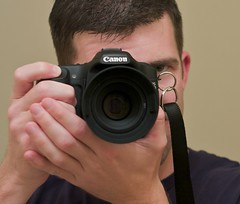
The Y Strap is handmade by Stephen M. Schaub. It cost $25 + shipping at the time of this review.
The Construction
The Y Strap is very simple: there are four parts. There is a loop of nylon webbing, a slide for adjusting where the camera hangs, and two key rings. One large key ring is attached to the webbing, the other is shipped loose. The optional smaller ring can be used as an adapter for certain cameras, like my 40D (see photos).
The camera attaches on one side to the key ring -- the maker suggests attaching the camera on the same side you wear it. The strap goes over the shoulder and across the chest. When you raise the camera to take a photo, the key ring slides up the strap.
Unlike the R-Strap, the Y Strap can't become unbuckled. There are no fasteners holding the strap together, just an adjustment slide. In the unlikely event the slide were to fail, the camera won't fall. The ends of the strap fed through the slide are sewn together so that the nylon makes a continuous loop even without it.
The point where the two ends of the strap are sewn together is quite clever. Others might just overlap the ends and sew, rivet, or buckle them together. Instead, the ends are stitched together a few inches shy of the ends, and the loose ends are sandwiched into the stitching, forming a tiny "Y" shaped tail (see the photos). This construction means that there are no exposed rough ends to fray or irritate your skin.
Do it Yourself?
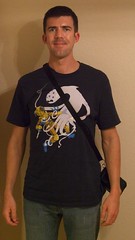 The beauty of the Y Strap comes from the simplicity. There are no complicated moving parts. There aren't even any markings except for a hand-written serial number hidden inside the "Y" where the ends are sewn together.
The beauty of the Y Strap comes from the simplicity. There are no complicated moving parts. There aren't even any markings except for a hand-written serial number hidden inside the "Y" where the ends are sewn together.Not everyone likes simplicity though. They point out -- correctly -- that most anyone could probably make an approximation of the Y Strap for much less than $25. You can find plans out on the internet for DIY straps. Most of them seem to imitate the R-Strap.
I'm okay with paying for labor, craftsmanship, and design though. Considering the thorough stitching holding the strap together, I'm surprised it's worth Stephen's time to sell these at $25 -- around half the price of the Black Rapid straps. The materials seem good too. The strap has a pleasantly soft and smooth texture. It's not the rough nylon strapping that you might use to lash a kayak to your car.
If you don't care about the details and just want something better than a normal neck strap, the DIY option will probably work fine. Just be careful to choose a design and materials that won't drop your camera on the pavement.
Possible Issues
My one reservation about the Y Strap was the reliance on key chain rings. I've never heard of a normal key ring failing, but it felt weird hanging an expensive SLR off of one. Incidentally, most of the reviews of the Y Strap are from users of the Leica cameras, not large SLRs. I'll be monitoring the condition of the rings closely.
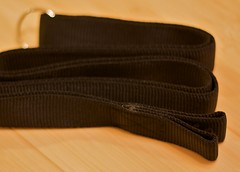 I haven't spent much time using the Y Strap in the field, but my initial impressions are good. If the strap length is adjusted correctly, the camera doesn't move too much when walking.
I haven't spent much time using the Y Strap in the field, but my initial impressions are good. If the strap length is adjusted correctly, the camera doesn't move too much when walking.With shorter lenses, like my 50mm f1.8, the camera tends to prefer resting with it's back against my side instead of, say, the back facing forward. This has resulted in accidental button presses. Since my neck strap had the same button issue, I won't call it a deal killer.
Longer lenses seem to do fine pointed backwards along my side. More field use will tell if walking around will cause zoom lenses like my 20-135mm to telescope out.
The key ring slides smoothly up the strap, but the strap still shifts some. Since there is no padding on the Y Strap, this isn't too big of a deal. The little tail of excess strap material does work lower and lower as the strap rotates. Field use should reveal if this is problematic.
The Advantages
Just to quickly sum up, here are my initial thoughts on why you might want a Y strap:
- Simplicity & elegance. The Y Strap doesn't attract attention (unless, maybe, you get it in red) or look goofy
- It doesn't put pressure on the neck
- It makes the camera less conspicuous
- It keeps the camera near your hands
- The camera bounces less
- It interferes with camera operations less
- It supports craftsmanship


